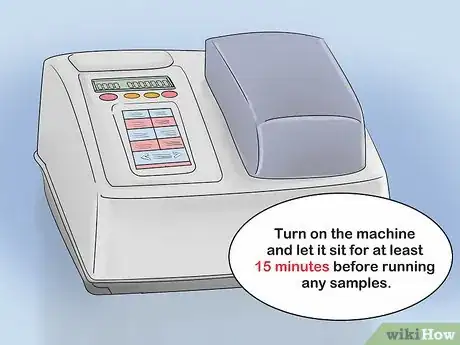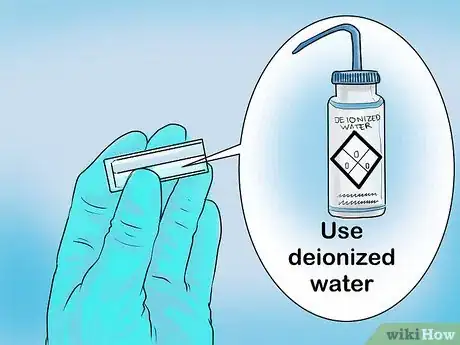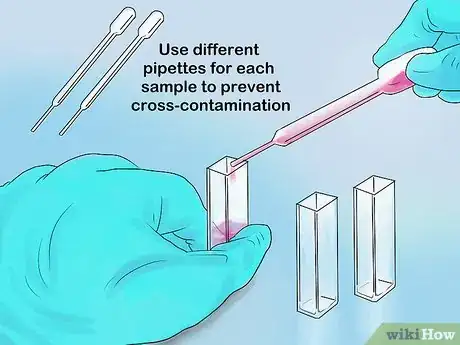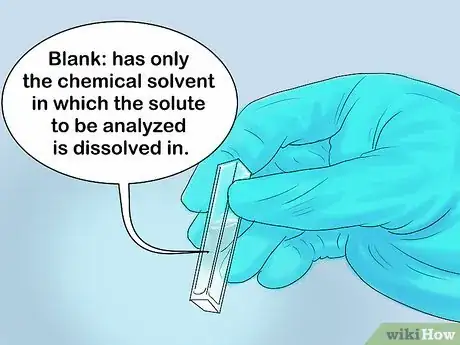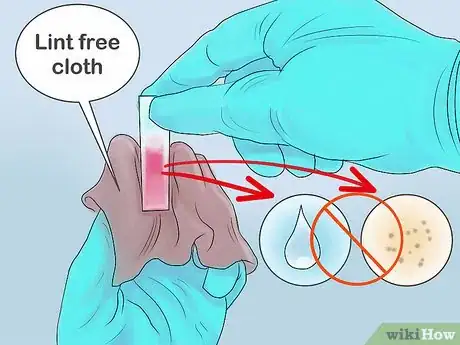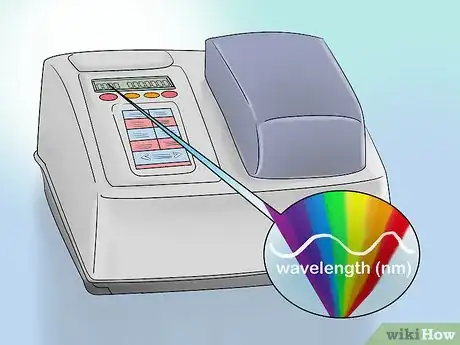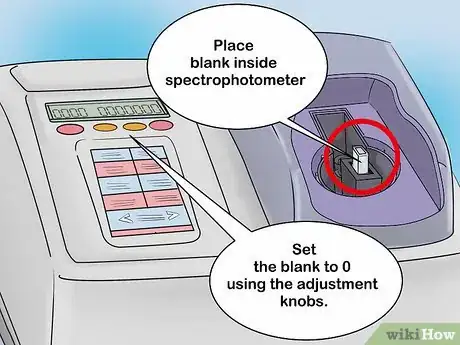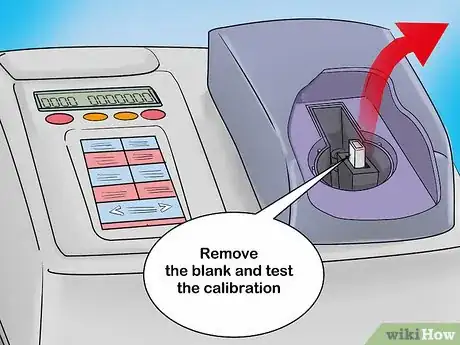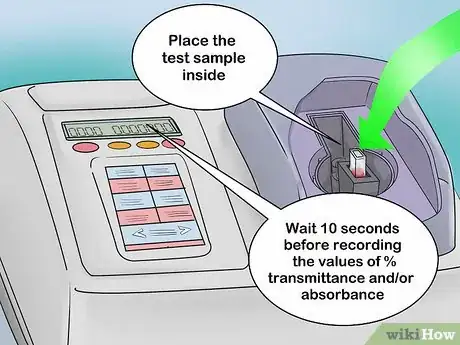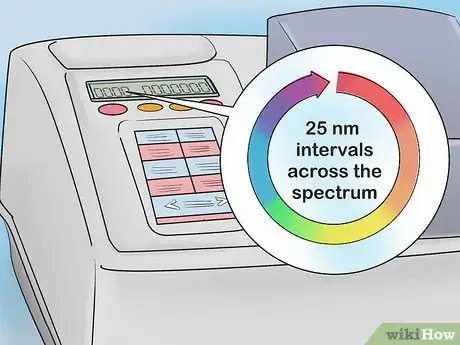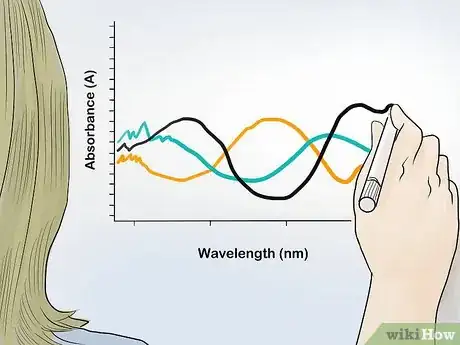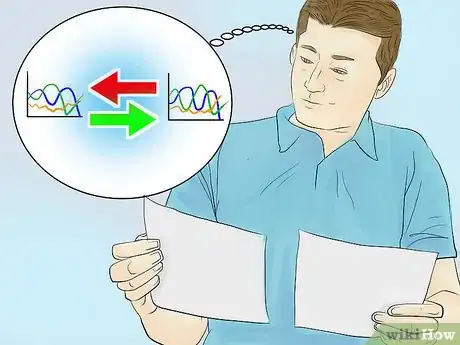This article was co-authored by Meredith Juncker, PhD. Meredith Juncker is a PhD candidate in Biochemistry and Molecular Biology at Louisiana State University Health Sciences Center. Her studies are focused on proteins and neurodegenerative diseases.
wikiHow marks an article as reader-approved once it receives enough positive feedback. This article received 11 testimonials and 90% of readers who voted found it helpful, earning it our reader-approved status.
This article has been viewed 236,295 times.
Spectrophotometry is an experimental technique that is used to measure the concentration of solutes in a specific solution by calculating the amount of light absorbed by those solutes.[1] This technique is powerful because certain compounds will absorb different wavelengths of light at different intensities. By analyzing the light that passes through the solution, you can identify particular dissolved substances in solution and how concentrated those substances are. A spectrophotometer is the device used to analyze solutions in a laboratory research setting.
Steps
Preparing the Samples
-
1Turn on the spectrophotometer. Most spectrophotometers need to warm up before they can give an accurate reading. Turn on the machine and let it sit for at least 15 minutes before running any samples.[2]
- Use the warm-up time to prepare your samples.
-
2Clean the cuvettes or test tubes. If you are doing a lab for school, you may be using disposable test tubes that don't need to be cleaned. If you are using cuvettes or reusable test tubes, make sure they are properly cleaned before use. Rinse each cuvette thoroughly with deionized water.
- Take care with cuvettes as they can be quite expensive, particularly if they are made from glass or quartz. Quartz cuvettes are designed for use in UV-visible spectrophotometry.
- When handling the cuvette, avoid touching the sides the light will pass through (generally, the clear sides of the container).[3] If you accidentally touch these sides, wipe the cuvette down with a kimwipe (which are formulated to prevent scratching the glass).
Advertisement -
3Load the proper volume of the sample into the cuvette. Some cuvettes have a maximum volume of 1 milliliter (mL) while test tubes may have a maximum volume of 5 mL. As long as the laser producing the light is passing through the liquid and not an empty part of the container, you will get an accurate reading.
- If you are using a pipette to load your samples, use a new tip for each sample to prevent cross-contamination.[4]
-
4Prepare a control solution. Known as a blank, the control solution has only the chemical solvent in which the solute to be analyzed is dissolved in. For example, if you had salt dissolved in water, your blank would be just water. If you dye the water red, the blank must also contain red water. The blank is the same volume as the solution to be analyzed and kept in the same kind of container.[5]
-
5Wipe the outside of the cuvette. Before placing the cuvette into the spectrophotometer you want to make sure it is as clean as possible to avoid interference from dirt or dust particles. Using a lint free cloth, remove any water droplets or dust that may be on the outside of the cuvette.[6]
Running the Experiment
-
1Choose and set the wavelength of light to analyze the sample with. Use a single wavelength of light (monochromatic color) to make the testing more effective. The color of the light chosen should be one known to be absorbed by one of the chemicals thought to be in the test solute. Set the desired wavelength according to the specifications of your spectrophotometer.[7]
- In a classroom lab, the wavelength will likely be given to you.
- Because the sample will reflect all light of the same color as it appears, the experimental wavelength will always be a different color than that of the sample.
- Objects appear as certain colors because they reflect light of particular wavelengths and absorb all other colors. Grass is green because the chlorophyll in it reflects green light and absorbs everything else.
-
2Calibrate the machine with the blank. Place the blank into the cuvette holder and shut the lid. On an analog spectrophotometer, there will be a screen with a needle that moves based on the intensity of light detection. When the blank is in, you should see the needle move to the right. Record this value in case you need it for later. With the blank still in the machine, move the needle to zero using the adjustment knob.[8]
- Digital spectrophotometers can be calibrated in the same way, they will just have a digital readout. Set the blank to 0 using the adjustment knobs.
- When you remove the blank, the calibration will still be in place. When measuring the rest of your samples, the absorbance from the blank will automatically be subtracted out.
- Be sure to use a single blank per session so that each sample is calibrated to the same blank. For instance, if you blank the spectrophotometer, then analyze only some of samples and blank it again, the remaining samples would be inaccurate. You would need to start over.
-
3Remove the blank and test the calibration. With the blank removed the needle should stay at 0 (zero) or the digital readout should continue to read 0. Place the blank back into the machine and ensure the needle or readout doesn't change. If the machine is properly calibrated with your blank, everything should stay at 0.
- If the needle or readout is not 0, repeat the calibration steps with the blank.
- If you continue to have problems, seek assistance or have the machine looked at for maintenance.
-
4Measure the absorbance of your experimental sample. Remove the blank and place the experimental sample into the machine. Slide the cuvette into the designated groove and ensure it stands upright. Wait about 10 seconds until the needle is steady or until the digital numbers stop changing. Record the values of % transmittance and/or absorbance.
- The absorbance is also known as the optical density (OD).
- The more light that is transmitted, the less light the sample absorbs. Generally, you want to record the absorbance values which will usually be given as a decimal, for example, 0.43.
- If you get an outlying result (such as 0.900 when the rest are around 0.400), dilute the sample and measure the absorbance again.
- Repeat the reading for each individual sample at least 3 times and average them together. This ensures a more accurate readout.
-
5Repeat the test with successive wavelengths of light. Your sample may have multiple unknown compounds that will vary in their absorbance depending on wavelength. To eliminate uncertainty, repeat your readings at 25 nm intervals across the spectrum. This will allow you to detect other chemicals suspected to be in the solute.
Analyzing the Absorbance Data
-
1Calculate the transmittance and absorbance of the sample. Transmittance is how much of the light that passed through the sample reached the spectrophotometer. Absorbance is how much of the light has been absorbed by one of the chemicals in the solute. Many modern spectrophotometers have an output of transmittance and absorbance, but if you recorded intensity, you can calculate these values.[9]
- The transmittance (T) is found by dividing the intensity of the light that passed through the sample solution with the amount that passed through the blank. It is normally expressed as a decimal or percentage. T = I/I0 where I is the intensity of the sample and I0 is the intensity of the blank.
- The absorbance (A) is expressed as the negative of the base-10 logarithm (exponent) of the transmittance value: A = -log10T.[10] For a T value of 0.1, the value of A is 1 (0.1 is 10 to the -1 power), meaning 10% of the light is transmitted and 90% is absorbed. For a T value of 0.01, the value of A is 2 (0.01 is 10 to the -2 power), meaning 1% of the light is transmitted.
-
2Plot the absorbance values versus the wavelengths on a graph. The absorbance value is plotted on the vertical y-axis against the wavelength of light used for a given test plotted on the horizontal x-axis. Plotting the maximum absorbance values for each wavelength of light tested, produces the sample's absorbance spectrum and identifies the compounds making up the test substance and their proportions.[11]
- An absorbance spectrum usually has peaks at certain wavelengths that can allow you to identify specific compounds.
-
3Compare your absorbance spectrum plot to known plots of specific compounds. Compounds have unique absorbance spectrum and will always produce a peak at the same wavelength every time they are measured. By comparing your plots of unknown compounds to those of known compounds, you can identify the solutes that compose your solution.[12]
- You can also use this method to identify contaminants in your sample. If you are expecting 1 clear peak at a specific wavelength and you get 2 peaks at separate wavelengths, you know something is not right in your sample.
Expert Q&A
Did you know you can get expert answers for this article?
Unlock expert answers by supporting wikiHow
-
QuestionWhy do you zero a spectrophotometer?
 Meredith Juncker, PhDMeredith Juncker is a PhD candidate in Biochemistry and Molecular Biology at Louisiana State University Health Sciences Center. Her studies are focused on proteins and neurodegenerative diseases.
Meredith Juncker, PhDMeredith Juncker is a PhD candidate in Biochemistry and Molecular Biology at Louisiana State University Health Sciences Center. Her studies are focused on proteins and neurodegenerative diseases.
Scientific Researcher You must "zero" your spectrophotometer before using it so all of your absorbance readings can have a baseline to be compared to. For example, if your protein sample was diluted with distilled water, you would zero or "blank" the spectrophotometer using just distilled water, that way the only difference between the absorbance readings can be attributed to protein concentration in the sample.
You must "zero" your spectrophotometer before using it so all of your absorbance readings can have a baseline to be compared to. For example, if your protein sample was diluted with distilled water, you would zero or "blank" the spectrophotometer using just distilled water, that way the only difference between the absorbance readings can be attributed to protein concentration in the sample. -
QuestionWhat are the different types of elements and compounds tested with a spectrophotometer?
 Meredith Juncker, PhDMeredith Juncker is a PhD candidate in Biochemistry and Molecular Biology at Louisiana State University Health Sciences Center. Her studies are focused on proteins and neurodegenerative diseases.
Meredith Juncker, PhDMeredith Juncker is a PhD candidate in Biochemistry and Molecular Biology at Louisiana State University Health Sciences Center. Her studies are focused on proteins and neurodegenerative diseases.
Scientific Researcher
-
QuestionHow do I prepare sample solutions to be tested for absorbance?
 Meredith Juncker, PhDMeredith Juncker is a PhD candidate in Biochemistry and Molecular Biology at Louisiana State University Health Sciences Center. Her studies are focused on proteins and neurodegenerative diseases.
Meredith Juncker, PhDMeredith Juncker is a PhD candidate in Biochemistry and Molecular Biology at Louisiana State University Health Sciences Center. Her studies are focused on proteins and neurodegenerative diseases.
Scientific Researcher This depends on what you're looking for. Here is how you would prepare a sample to determine protein content in a solution. 1) Lyse cells from experiment with lysis buffer (we use 4% SDS lysis buffer) in an eppendorf tube. 2) Sonicate the cells to help break them open, allowing proteins from inside the cell to move into the lysis buffer. 3) Boil samples at 100 degrees Celsius for 10 minutes. 4) Centrifuge your samples at 13,000 g for 2 minutes. 5) I flick the the eppendorf tube with my finger to ensure proper mixing and then centrifuge again. 6) Take 10 microliters of your sample and add it to 990 microliters of double deionized water. Vortex to mix. 7) Take your sample (1mL) and measure its absorbance in the spectrophotometer as described above.
This depends on what you're looking for. Here is how you would prepare a sample to determine protein content in a solution. 1) Lyse cells from experiment with lysis buffer (we use 4% SDS lysis buffer) in an eppendorf tube. 2) Sonicate the cells to help break them open, allowing proteins from inside the cell to move into the lysis buffer. 3) Boil samples at 100 degrees Celsius for 10 minutes. 4) Centrifuge your samples at 13,000 g for 2 minutes. 5) I flick the the eppendorf tube with my finger to ensure proper mixing and then centrifuge again. 6) Take 10 microliters of your sample and add it to 990 microliters of double deionized water. Vortex to mix. 7) Take your sample (1mL) and measure its absorbance in the spectrophotometer as described above.
Things You'll Need
- Spectrophotometer
- Substance in solution to be analyzed
- Additional solvent (for blank solution)
- Containers for test and blank solutions (cuvettes, test tubes, etc.)
References
- ↑ http://www2.bren.ucsb.edu/~keller/courses/esm223/Spectrometer_analysis.pdf
- ↑ https://bio.libretexts.org/Bookshelves/Biotechnology/Lab_Manual%3A_Introduction_to_Biotechnology/01%3A_Techniques/1.06%3A_Spectrophotometry
- ↑ http://www2.bren.ucsb.edu/~keller/courses/esm223/Spectrometer_analysis.pdf
- ↑ http://www2.bren.ucsb.edu/~keller/courses/esm223/Spectrometer_analysis.pdf
- ↑ https://bio.libretexts.org/Bookshelves/Biotechnology/Lab_Manual%3A_Introduction_to_Biotechnology/01%3A_Techniques/1.06%3A_Spectrophotometry
- ↑ http://www2.bren.ucsb.edu/~keller/courses/esm223/Spectrometer_analysis.pdf
- ↑ https://chem.libretexts.org/Bookshelves/Physical_and_Theoretical_Chemistry_Textbook_Maps/Supplemental_Modules_(Physical_and_Theoretical_Chemistry)/Kinetics/02%3A_Reaction_Rates/2.01%3A_Experimental_Determination_of_Kinetics/2.1.05%3A_Spectrophotometry
- ↑ https://bio.libretexts.org/Bookshelves/Biotechnology/Lab_Manual%3A_Introduction_to_Biotechnology/01%3A_Techniques/1.06%3A_Spectrophotometry
- ↑ https://chem.libretexts.org/Bookshelves/Physical_and_Theoretical_Chemistry_Textbook_Maps/Supplemental_Modules_(Physical_and_Theoretical_Chemistry)/Kinetics/02%3A_Reaction_Rates/2.01%3A_Experimental_Determination_of_Kinetics/2.1.05%3A_Spectrophotometry
- ↑ http://www.chm.davidson.edu/vce/spectrophotometry/Spectrophotometry.html
- ↑ https://chem.libretexts.org/Bookshelves/Physical_and_Theoretical_Chemistry_Textbook_Maps/Supplemental_Modules_(Physical_and_Theoretical_Chemistry)/Kinetics/02%3A_Reaction_Rates/2.01%3A_Experimental_Determination_of_Kinetics/2.1.05%3A_Spectrophotometry
- ↑ https://chem.libretexts.org/Bookshelves/Physical_and_Theoretical_Chemistry_Textbook_Maps/Supplemental_Modules_(Physical_and_Theoretical_Chemistry)/Kinetics/02%3A_Reaction_Rates/2.01%3A_Experimental_Determination_of_Kinetics/2.1.05%3A_Spectrophotometry
About This Article
Before doing a spectrophotometric analysis, turn on the machine so that it can warm up for 15 minutes prior to running samples. Meanwhile, pipe your sample substance into one cuvette, and a control solution, like water, into another. Then, set the desired wavelength on the machine and place the cuvette with the control solution inside to calibrate it. Next, set the needle to zero before replacing the control solution with your sample. After 10 seconds, read the percentage values and record them before removing the sample. For tips from our Science reviewer on how to use the results of your analysis to calculate the transmittance and absorbance of the sample, read on!
